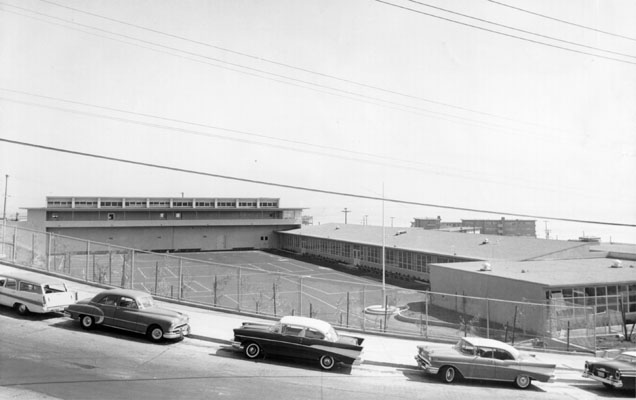Die bemalte Stadt: Initiativen zur Veränderung der Strassen in USA; Beispiele in Europe by Horst Schmidt-Brümmer and Feelie Lee from 1973 is a study of street art -- both mural and advertising art. In English the book's title would The Painted City: Initiatives to Change The Streets in the USA; Examples in Europe. It is richly illustrated with photographs from that time, most from California. A good number of the images are from the Bay Area.
The authors present these visual examples from the United States to encourage their European audience to enliven their public spaces.They delight in what they describe as an everyday, colloquial visual language on American streets. One of the subject headings for the volume is Urban beautification -- United States.
Even through the German text may not be welcoming to many of our readers, the book's photo-documentation is a treat and features a few dozen images of San Francisco scenes, mostly of artwork that disappeared long ago.
One example is an image of the Shandygaff restaurant at 1760 Polk Street (at Washington Avenue). This establishment was a trailblazer in the health food movement. According to Inside the California Food Revolution, Shandygaff was where Mollie Katzen of Moosewood Cookbook fame received her training.
The immense lettering on the business's exterior also caused a sensation. Herb Caen remarked:
Shandygaff, that wild-looking new restaurant at Polk and Washington -- the name is in letters about 10 feet high, wrapping around the corner -- is owned by Atty. Rubin Glickman, who let Graphics Designer Marget Larsen really do her eye-popping thing.The letters actually look like they are 15 feet tall. Marget Larsen had been the art director for the Joseph Magnin stores and is considered along with Barbara Stauffacher Solomon to have been one of the earliest designers of "supergraphics."
There are other available images of Marget Larsen's design.
For instance from the San Francisco Chronicle of June 27, 1971.
Or through the Design Library Image Collection at North Carolina State University.
The image in Die bemalte Stadt is very clear and well-framed and is a welcome documentation of this significant work of graphic design.
Shandygaff Health Food Restaurant - Vegetarisches Restaurant, Polk St., San Francisco
By 1974 the restaurant replaced Larsen's design with a colorful Timothy Jenk mural depicting nineteenth century agrarian life. The space is still a restaurant today, but it sports a far less audacious copper and orange exterior.
While many of the examples in Schmidt-Brümmer and Lee's book are of commercial graphic art, there are also many instances of community-based murals. Co-author Feelie Lee also published a photograph of a mural at the Hunters Point No. 2 Elementary School in the California Living Magazine of March 1973.
She contributed a fuller black and white image of the mural in Die Malte Stadt.
Hunters Point II Elementary School - Volksschule, Kiska Road, San Francisco
This untitled artwork was created by Dewey Crumpler in 1972 not long after completing his mural studies in Mexico. He was eager to undertake this project because he had attended this school growing up in Hunters Point.
The work depicts a young man and woman (left and right sides) absorbed in books. Behind them are images from colossal books of important African-American figures like W.E.B. Dubois, Harriet Tubman, Malcolm X, Dr. Martin Luther King and Muhammed Ali. Further in the background are sheltering wings of elders who guard this knowledge. Crumpler wished to communicate the "importance of education and wisdom gained over time" (personal communication).
There are young people at the foreground of the mural that regard these volumes and historical figures with awe and reverence. The photograph from Die bemalte Stadt supplements those painted children with the children of the school. While enjoying their time learning and at play they can also appreciate these inspirational figures.

The Hunters Point II School (image source: San Francisco Historical Photograph Collection)
The Hunters Point II School was originally called the Ridgecrest No. 3 School and opened in 1944. Like the neighborhood itself, the school was constructed quickly and cheaply to serve armament workers how moved to San Francisco in large numbers from the South. It was reconstructed in 1953 but was ultimately closed and torn down in 1975.
This work was not mentioned in A Checklist of San Francisco Murals from 1986, but Crumpler does include it among the commissioned works listed on his online resume.
Die bemalte Stadt is valuable to us today because it documents a visual medium and a visual landscape that is frequently destroyed or lost. Both the Marget Larsen and Dewey Crumpler works discussed here were gone after only a few years, but learning about these works increases our understanding of these artists and of San Francisco society and its art world at that time.
Anderson, Judith, "Murals: A New Way To Dress Up Buildings," San Francisco Chronicle (September 2, 1974).
Caen, Herb, "Just Foolin' Around," San Francisco Chronicle (November 18, 1970).
A Checklist of San Francisco Murals, 1914-1986, edited by Tim Drescher and Victoria Scarlett. (J. Paul Leonard Library, San Francisco State University, 1986).
Goldstein, Joyce and Dore Brown, Inside The California Food Revolution: Thirty Years That Changed Our Culinary Consciousness (University of California Press, 2013).
Isenberg, Alison, Designing San Francisco: Art, Land, and Urban Renewal in the City by the Bay (Princeton University Press, 2017).
Lee, Feelie, "The People's Art Gallery," San Francisco Examiner & Chronicle California Living Magazine (March 11, 1973).
Resume, Dewey Crumpler [website].
Schmidt-Brümmer, Horst and Feelie Lee, Die bemalte Stadt: Initiativen zur Veränderung der Strassen in USA; Beispiele in Europe (DuMont-Schauberg, 1973).














